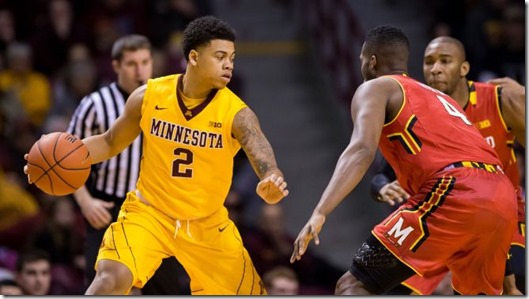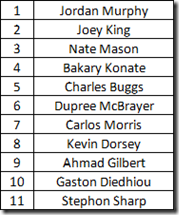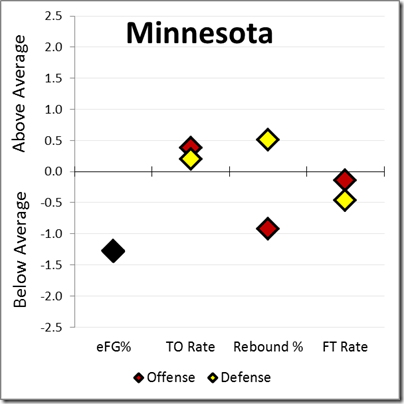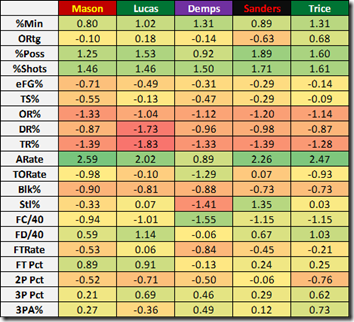Nate Mason [Brad Rempel – USA Today]
PREVIOUSLY: Illinois, Indiana, Iowa, Maryland, Michigan, Michigan St.
After deciding to fire Tubby Smith after an underwhelming six years in the Twin Cities, Minnesota decided to go in a different direction with their next coach; Richard Pitino does have a famous basketball name, but he was very young, enthusiastic, and inexperienced when he got the Minnesota job – he’d only been a head coach for one season. It was a bold gamble and so far, it hasn’t worked out. In his first season (2013-14) at the helm, the Gophers barely missed the NCAA Tournament and their record slipped a little bit the next season, but Minnesota was at least a decent team.
The bottom fell out last season. In the month of November, Minnesota went 5-2 without any bad losses (and they even had a pretty good win over Clemson), but they were absolutely terrible for the rest of the season, posting a record of 3-21 after the calendar flipped to December. It took them until the 14th game of conference play to get their first win, upsetting Maryland at home in what was perhaps the most surprising result in all of Big Ten play last season. After a few key suspensions late in the season, they finished the year with a 23-point loss to Rutgers (who was previously winless in the Big Ten) and a 33-point defeat to Illinois in the Big Ten Tournament.
Usually by the time a coach gets to his third season in a new job, the program is pretty much his; holdovers from Tubby helped Pitino early on, but once the personnel was mostly recruited by him, the Gophers had a major slide. He retained his job and has a surprisingly high buyout, but unless last year was an extreme aberration, the long-term prognosis doesn’t look good. To be fair, they were a young team last season and there are signs of hope – junior guard Nate Mason is the best player Pitino brought in, Jordan Murphy was a pleasant surprise last year as a freshman, there are good transfers and a good recruiting class coming in, etc. – but there will need to be progress or Minnesota will be looking for a new coach fairly soon.
[More on the Gophers after the JUMP]
LAST SEASON
Unsurprisingly, most of the Gophers were inefficient players; they scored just 0.95 points per possession in conference play and somehow only hit 29% of their three-point attempts against Big Ten opponents – their eFG% was the worst in the league. Joey King, a senior stretch-four who hit 45% of his threes, was the only exception, and he’s gone now.
Nate Mason and Jordan Murphy were the key players for the Gophers, playing heavy minutes and posting relatively decent efficiency numbers relative to their usage. Mason, a point guard, had a great assist to turnover ratio, which boosted his offensive rating – his three-point shooting (30%) dragged that number down a bit.
Murphy – a freshman who showed some really positive things on the defensive end and as a rebounder – was forced to take far more shots than he was comfortable with after the suspensions of Mason, Dupree McBrayer, and Kevin Dorsey. He averaged 17 FGA per game with those three out, and that helps explain his low efficiency number.
Minnesota’s role players were not very good (outside of King, who was legitimately decent in his role). Bakary Konate is the most notable of those players; the big man turned in a decent TS% but was plagued by turnovers. McBrayer, a combo guard with decent size, posted an eFG% of 37 – a terrible number.
Four Factor Z-Scores from games against Big Ten opponents
With equally poor shooting and shot defense numbers, Minnesota didn’t have a chance. In Big Ten play, they shot an eFG% of 44.7 and allowed 53% – meaning that opponent shots were worth 0.17 points per possession more than Gopher shots. Even though they were pretty average at everything else, it’s impossible to win consistently with that kind of shooting and shot defense.
NEWCOMERS
Minnesota has struggled to sign the marquee players from the Twin Cities area in recent years, but they were able to secure the commitment of Amir Coffey, a Gopher legacy and Top 50 player – the best prospect from the state in the 2016 class. Coffey is a 6’8 shooting guard who could theoretically guard the 2, 3, (and eventually 4, once he puts on more size) and he has a tantalizing offensive game – his outside shot is probably his weakest point, but he can get to the basket and the free throw line with ease and should have a size and length advantage over most opponents. Coffey will surely see starter minutes right away for the Gophers and could be an instant impact player – something that Minnesota sorely needs.
Coffey is joined by fellow 4* Eric Curry, a Tennessean who played his prep hoops in Arkansas. Curry is considered to be a PF by 247, but will likely play as a stretch-4. He has good size at 6’8 and should be able to compete for a starting spot right away – it’s possible that he’s already one of the best shooters on the team, and he’s long and athletic enough to make an impact on the defensive end as well. Between Coffey and Curry, Pitino definitely upgraded the talent level and while it’s usually tough to ask too much of freshmen, they’ll be counted on early in their careers. Also in the class is 3* MN SF Michael Hurt, who could also get minutes on the wing.
Pitino also added some key transfers. Reggie Lynch spent two years at Illinois State and actually had the top block rate in the country in both seasons – though his propensity for fouls made it hard to keep him on the floor. He was still one of the better players in the Missouri Valley Conference and should be the starting center for the Gophers because of his rim protection and offensive rebounding abilities. Another transfer becomes eligible this year – Davonte Fitzgerald, a wing who spent two years at Texas A&M but tore his ACL when in College Station. He actually regressed as a sophomore – likely due to the injury – but he’s a decent bet to keep starting because of the depth chart on the wing.
PROJECTED ROTATION
- STARTER (POINT GUARD) – Nate Mason (Jr, 6’2, 190): Assist rate of 32.1, turnover rate of 12.5, shooting splits were mediocre at 44 / 30 / 80 (2P% / 3P% / FT%), is often leveraged into inefficient mid-range shots, probably Minnesota’s best player.
- STARTER (WING) – Amir Coffey (Fr, 6’8, 195): Star freshman will be counted on right away, has the potential to be the Gophers’ leading scorer, has above-average size as an NBA 2-guard prospect, needs to work on his outside shot.
- STARTER (WING) – Davonte Fitzgerald (R-Jr, 6’8, 220): Athletic, versatile wing was a promising player at Texas A&M before an ACL injury, statistical profile isn’t encouraging but he definitely has the talent to play significant rotation minutes.
- STARTER (TRADITIONAL FOUR) – Jordan Murphy (So, 6’6, 240): Tenacious rebounder can play either forward position (and is probably best as a four), posted encouraging block and steal rates (4.1 and 2.3), gets to the free throw line a lot but only hits 61%, foul prone.
- STARTER (POST) – Reggie Lynch (R-Jr, 6’10, 260): Had the top block rate in the country in both seasons at Illinois State, committed 6.7 fouls / 40 as a sophomore, best O-Reb rate in the MVC that season, draws fouls, good TS%.
- BENCH (COMBO GUARD) – Dupree McBrayer (So, 6’5, 190): Good court vision, gets steals, can draw fouls, shooting splits were awful last year at 37 / 25 / 62, will probably be Minnesota’s sixth man.
- BENCH (GUARD) – Stephon Sharp (So, 6’3, 190): Forced into action later in the season (and forced to play starter minutes after the suspensions), Sharp didn’t distinguish himself much on the floor.
- BENCH (WING) – Ahmad Gilbert (So, 6’6, 205): Horrendous shooting splits (38 / 23 / 46) on a small sample size of attempts, gets some steals, sub-80 offensive rating.
- BENCH (WING) – Eric Curry (Fr, 6’9, 235): Freshman is less hyped than Coffey but still a fringe Top 100 player who picked Minnesota over decent offers, inside-outside four who should provide spacing and could fill the role vacated by Joey King.
- BENCH (POST) – Bakary Konate (Jr, 6’11, 235): Great size and good rebounding rates, solid rim protector (5.1 block rate), stone hands, decent finisher when he can catch the ball, doesn’t get to the FT line that much but a decent % for a big man (68%).
PLAYER COMPARISON
A few years ago, I came up with a system that would compare the statistical profiles of Big Ten players to their historical counterparts by taking the sum of the differences between a given player’s profile and each of the thousand player-seasons from 2008-present in twenty different statistical categories.
# value is the Z-Score of the player’s statistic (or statistics averaged over multiple seasons) relative to the entire sample
It’s hard not to wonder what Nate Mason would look like on a better team: even though he was surrounded by poor scorers, he still had one of the best assist rates in the Big Ten and if he was able to be a more complementary scorer, his shooting percentages would surely rise. It was a surprise to see some great player-seasons so high on his list of comparables; Travis Trice’s excellent senior year, two seasons from Jordan Taylor, and a Trey Burke appearance speaks well to Mason’s game.
Former Michigan State point guard Kalin Lucas is probably the best comparison, though Lucas was better than Mason is. Still, the statistics for the two are pretty similar: Lucas was slightly more efficient on about the same usage rate, though Mason posted better assist numbers. In terms of style, they’re pretty similar – penetrating point guards who have a tough time finishing at the rim because of their size (or lack thereof). Again, Lucas was better, but it’s an encouraging sign that Mason looks pretty decent in comparison.
OUTLOOK
In hindsight, the youth on Minnesota’s team last season probably meant that a step back was likely, but nobody could have predicted that they’d fall so far. Because Rutgers is also in the conference, Minnesota wasn’t the worst team in the Big Ten – but in most years, they would have been. Bouncing back from such an awful season is very difficult, but if Minnesota makes tangible strides and perhaps reaches the NIT, that would be evidence that things are moving in the right direction – probably enough that Pitino’s job would be safe.
That there are some talented players coming in makes that type of improvement possible. Amir Coffey is the best prospect to choose Minnesota in some time and, with the level of playing time he’ll surely get, he’s a relatively safe bet to be on the All-Big Ten freshman team. Reggie Lynch might be the most interesting transfer in the league; he probably won’t be able to handle heavy minutes because of his proclivity for fouling, but he’ll upgrade the Gopher defense immediately and substantially when he’s on the floor. Between Eric Curry and Davonte Fitzgerald, there are new options on the wing. Nate Mason and Jordan Murphy were decent players on a bad team this year, and playing with better teammates should help in their development.
Still, there’s a long way to go. They had more than their fair share of close losses last year, but they only won eight games total; even if they had better luck in those contests (and luck in close games is correlated with general team ability on some level, so it’s not a surprise that they were so bad in those games), they still would have had a losing record. Coffey, Lynch, Curry, and Fitzgerald can only do so much – the entire nucleus of the team should be back in 2017-18 and that’s probably the earliest that Minnesota will be able to work itself back onto the bubble.





